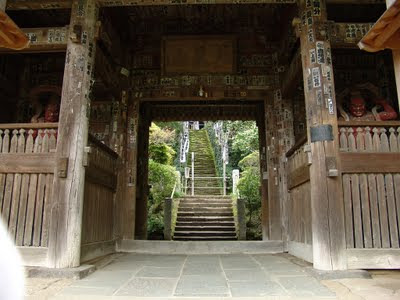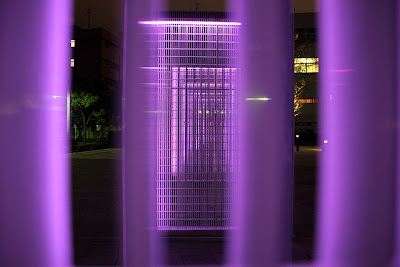陰陽 In and Yo: The Fists and Breath of 仁王尊 Niou
From Bujinkan Santa Monica by Bujinkan Santa Monica
 |
| Sugimoto-dera temple, Kamakura. photo by Flowizm |
But I didn't get it. Maybe I needed more life experience to understand. Maybe I needed a teacher who could do more than just talk about the concept but one who actually lived it. Whatever it was, I now find myself feeling like a beginner being inspired by this concept as if for the first time.
One of the songs of the Gokui that Hatsumi Sensei has shared with us:
"The two guardian gods take the form of In and Yo. The movement of their fists, and also the breath."Hatsumi Sensei changes the kanji to help us understand that this sacred song (seika 聖歌), can only be understood if we make it a living song (seika 生歌).
How do we make this idea come alive?
To begin with, don't get lost in the philosophy. The symbolism in our art also has a real physical manifestation. I mean, you can use it in a fight.
陰 (In) can be shown by tranquility and inaction; and 陽 (Yo) can be shown by movement or action. Before fighting, you should have a calm exterior(In). While your mind remains active and alert (Yo), flowing yet fixing on nothing.
When attacking, your body goes into action (Yo) while your mind should stay calm and quiet (In). These flow from one into the other.
"... I do not fight for gain or loss, am not concerned with strength or weakness, and neither advance a step nor retreat a step. The enemy does not see me. I do not see the enemy. Penetrating to a place where heaven and earth have not yet divided, where Yin and Yang have not yet arrived, I quickly and necessarily gain effect." - Takuan SohoIn the Gokui song the two guardian gods are the Kongou Rikishi or the Niou 仁王尊, shown in the temple gates in the photo above. They represent the use of overt power and latent power. Naraen is also called Narayana. As a pair, the Niō complement each other. Misshaku (aka Agyō 阿形) represents overt power, baring his teeth and raising his fist in action, while Naraen (aka Ungyō 吽形) represents latent might, holding his mouth tightly closed and waiting with both arms tensed but lowered.
They may appear different, but we must understand the connection and flow between these two. As Soke said some years ago,
"Life & death are connected. Like in-yo (yin-yang). This is my teaching theme for the year. Like a magnet and metal, life and death are attracted to each other, always getting closer. If you are born and given a life, death is inevitable. When death comes do not be surprised or shaken. Get on the rhythm of life. Get in balance with it."This connection is like a rope or a spider's thread that you don't want to break. If you try to unravel In and Yo they dissolve and harmony dissolves with them. One is necessary for the other.
In fighting, If your body is active (Yo) and your mind is also in motion, you can become uncoordinated and easily defeated. This is like lashing out with a mind clouded by anger or fear. Conversely having an inactive body (In) and inattentive mind is like being caught off guard or being helpless and incapable of fighting.
Better to have one connected to the other so that as one shifts the other shifts in harmony.
Hatsumi Sensei recently described the Godan test as having a connection from the Kami above down through the upraised sword and heart of the person cutting... connected down to the heart and spirit of the person sitting. Neither person should sever that connection if they want to live through the test.
In class, Sensei told us to go further than even that:
"No technique or form, no yin or yang, or kyojitsu. Go beyond this. Do Kamiwaza. I teach things you shouldn't be able to understand."This gets us to the real secret of InYo. As in the picture of the temple above, you have to pass THROUGH the middle and beyond In and Yo to get to the true meaning inside. Don't be frightened by the fierce expression on the temple guardians' faces. Just walk through the gate.
I've been exploring this in my life and in my taijutsu. Allowing the inside and outside to be as one. Keeping this connection from above alive and fluid has made for many wonderful techniques in my training, but also creates moments of wonder and surprise in my life. But it's not me doing it. It's just part of the natural flow.








 Duncan was Nagato Shihan’s sole uke at the Bujinkan Hombu for two years when studying direct from the Gyokko Ryu and Kukishinden Ryu Densho. Duncan has also studied Nihon Buyo (Traditional Japanese Dance) under the direction of Noguichi Sensei.
Duncan was Nagato Shihan’s sole uke at the Bujinkan Hombu for two years when studying direct from the Gyokko Ryu and Kukishinden Ryu Densho. Duncan has also studied Nihon Buyo (Traditional Japanese Dance) under the direction of Noguichi Sensei.




